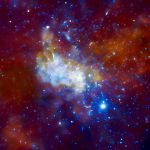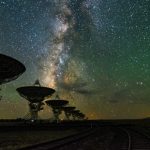The accretion disk around our galaxy’s black hole has been spotted at last0
- From Around the Web, Space
- June 5, 2019
The finding confirms that gases are orbiting the Milky Way’s gravitational behemoth

The finding confirms that gases are orbiting the Milky Way’s gravitational behemoth

The first surveys of massive black holes in dwarf galaxies turn up surprises

Sean McWilliams, an assistant professor at West Virginia University, has developed a mathematical method for calculating black hole properties from gravitational wave data. He has written a paper describing his method and posted it on the arXiv preprint server. The paper has been accepted for publication in Physical Review Letters.

Astrophysicists have detected the gravitational waves produced by a black hole colliding with a neutron star.

Its diameter suggests the black hole is 6.5 billion times the mass of the sun

Last week, the Event Horizon Telescope (EHT) released the first-ever image of a black hole’s shadow cast against the hot gas of its accretion disk. That image, of the black hole at the center of galaxy Messier 87 (M87), was front page news all over the world. Soon, the EHT will produce the first movie of that hot gas whirling chaotically around the shadow, said project leaders who spoke Sunday (April 14) here at the April meeting of the American Physical Society.

Scientists crunched data gathered by a global network of eight radio telescope observatories

Astronomers have taken the first ever image of a black hole, which is located in a distant galaxy.

In a few months, astronomers are going to be pointing their telescopes to Sagittarius A*, the supermassive black hole at the centre of our galaxy.

An international team of researchers has put a theory speculated by the late Stephen Hawking to its most rigorous test to date, and their results have ruled out the possibility that primordial black holes smaller than a tenth of a millimeter make up most of dark matter. Details of their study have been published in this week’s Nature Astronomy.